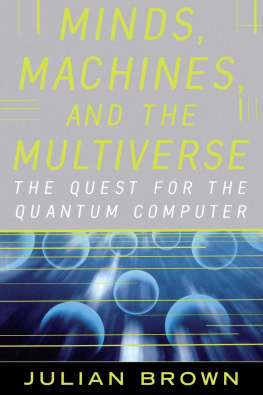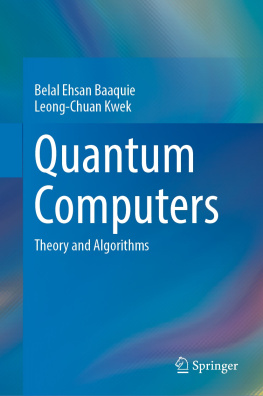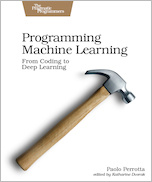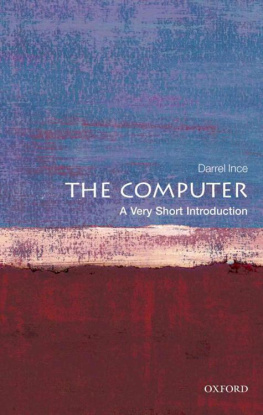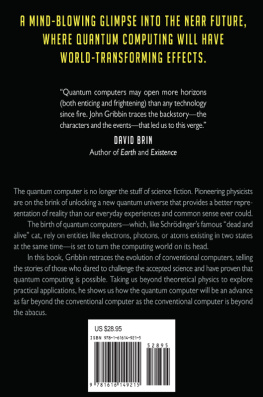| Minds, Machines, and the Multiverse: THE QUEST FOR THE QUANTUM COMPUTER |
| Julian Brown |
| Simon & Schuster (2002) |
|
| Tags: | Non-Fiction, Physics, Science |
| Non-Fictionttt Physicsttt Sciencettt |
The traditional and ubiquitous digital computer has changed the world by processing series of binary ones and zeroes...very fast. Like the sideshow juggler spinning plates on billiard cues, the classical computer moves fast enough to keep the plates from falling off. As computers become faster and faster, more and more plates are being added to more and more cues. Imagine, then, a computer in which speed is increased not because it runs faster, but because it has a limitless army of different jugglers, one for each billiard cue. Imagine the quantum computer. Julian Brown's record of the quest for the Holy Grail of computing -- a computer that could, in theory, take seconds to perform calculations that would take today's fastest supercomputers longer than the age of the universe -- is an extraordinary tale, populated by a remarkable cast of characters, including David Deutsch of Oxford University, who first announced the possibility of computation in the Alice-in-Wonderland world of quantum mechanics; Ed Fredkin, who developed a new kind of logic gate as a true step toward universal computation; and the legendary Richard Feynman, who reasoned from the inability to model quantum mechanics on a classical computer the logical inevitability of quantum computing. For, in the fuzzily indeterminate world of the quantum, new computing power is born. Minds, Machines, and the Multiverse details the remarkable uses for quantum computing in code breaking, for quantum computers will be able to crack many of the leading methods of protecting secret information, while offering new unbreakable codes. Quantum computers will also be able to model nuclear and subatomic reactions; offer insights into nanotechnology, teleportation, and time travel; and perhaps change the way chemists and biotechnologists design drugs and study the molecules of life. Farthest along the trail blazed by these pioneers is the ability to visualize the multiple realities of the quantum world not as a mathematical abstraction, but as a real map to a world of multiple universes...a multiverse where every possible event -- from a particular chess move to a comet striking the Earth -- not only can happen, but does. Incorporating lively explanations of ion trap gates, nuclear magnetic resonance computers, quantum dots, quantum algorithms, Fourier transforms, and puzzles of quantum physics, and illustrated with dozens of vivid diagrams, Minds, Machines, and the Multiverse is a mind-stretching look at the still-unbuilt but fascinating machines that, in the words of physicist Stanley Williams, "will reshape the face of science" and offer a new window into the secrets of an infinite number of potential universes. **

SIMON & SCHUSTER
New York London Toronto Sydney Singapore
Acknowledgments
Anything you can do in classical physics, we can do better in quantum physics. I heard that remark in Boulder, Colorado, a few years ago when Dan Kleppner, a distinguished MIT quantum physicist, was giving a lecture to a group of scientists on the subject of quantum chaos. His comment struck me at the time as particularly apposite because I saw it as being in many ways a leitmotif for this book.
Quantum physics appears to be a supreme overarching theory of the universe. Nuclear physics, atomic spectroscopy, chemistry, electronics, materials science, the physics of stars and black holes, and even the structure of the universe, all depend crucially on the laws of quantum theory. Yet in our everyday lives most of us are normally only aware of the classical physics that Newton brought to the fore. That quantum physics is built upon strange unworldly behavior at the atomic level has been appreciated by scientists for much of the twentieth century. There have been hints that quantum physics can engender unusual states at the macroscopic level too: Witness the phenomena of superconductivity and superfluidity. But for a profound theory, such things would appear to be curiously limited in scope.
Now, a century after the first faltering steps in the development of quantum theory and a half century after the invention of the digital computer, we are witnessing a scientific revolution that could put the theory into greater public prominence, while transforming our understanding of computing science and physics. For the realization is that quantum mechanics offers completely new ways to process information . Indeed, quantum physics is not simply better than classical physics in this regard, it appears to be unimaginably more powerful.
The purpose of this book is to tell the story of how this scientific revolution has come about. My intention has not been simply to explain the ideas but to articulate the motivations, actions, and grand visions of some of the leading scientists involved. Inevitably, I will have overlooked some important contributions and perhaps misinterpreted others, and for that I can only apologize to the people concerned.
For a book aimed at the general reader, I have not completely avoided offering some mathematically demanding material. In his book A Brief History of Time, Stephen Hawking revealed that his editor had warned him that for each equation he added to the manuscript he could expect his sales figures to halve. I have, foolishly perhaps, ignored that advice by including some semimathematical treatments and explanations here and there, though I have made the concession of consigning most of them to the back of the book, in the appendices, where they can perhaps be safely ignored. The reason I was keen to include at least some mathematical descriptions was simply that in my own study of quantum computation the only time I really felt that I understood what was happening in a quantum program was when I examined some typical quantum circuits and followed through the equations. The good news is that the circuits and equations themselves (or at least the ones I have included here) are not all that complicated. The most difficult aspect of them is the notation employed, which to the uninitiated will, no doubt, look rather strange. For the mathematically challenged, my advice is simply to skip any sections that prove too difficult. Gaps here or there in ones knowledge shouldnt spoil the big picture.
Quantum physics certainly represents an alien world to most people. Couple that with the hard-nosed logic of computation and you might think you are in for a difficult journey through a rarefied and abstract terrain. Fortunately, that is very far from the case. Quantum computation is, in itself, astonishingly compelling, but the subject also has a very human face, populated as it is by many deep-thinking and charismatic characters, some of whom I have had the privilege of meeting and talking to at length during the course of writing this book.
Among the people I would particularly like to thank for their stimulating and hugely enlightening conversations are David Deutsch and Artur Ekert, both of whom read through the text and offered many invaluable suggestions; Ed and Joyce Fredkin, who were kind enough to put me up at their house in Boston when I attended the PhysComp 96 symposium; and Charles Bennett, Peter Shor, David Di Vincenzo, Seth Lloyd, Tom Toffoli, Norman Margolus, Gilles Brassard, John Presskill, William Wootters, John Smolin, Jeff Kimble, Neil Gershenfeld, David Cory, Andrew Steane, David Wineland, Chris Monroe, Richard Hughes, Paul Townsend, Arjen Lenstra, William Athas, Tom Knight, and Rolf Landauer, who sadly died earlier this year.

